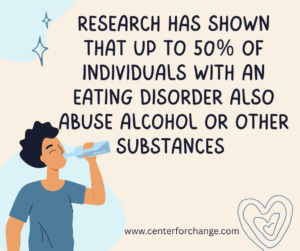Please note that this is an Archived article and may contain content that is out of date. The use of she/her/hers pronouns in some articles is not intended to be exclusionary. Eating disorders can affect people of all genders, ages, races, religions, ethnicities, sexual orientations, body shapes, and weights.
By Quinn Nystrom
In 1987, April was designated as Alcohol Awareness Month to raise awareness and encourage open conversations in schools, homes, and workplaces. You might wonder why I’m choosing to write about alcohol for an eating disorder treatment facility blog. Research has shown that up to 50% of individuals diagnosed with an eating disorder also abuse alcohol or other substances, compared to just 9% of the general population (Gregorowski et al., 2013). I am part of that 50%.
The National Eating Disorder Association says, “The risk of premature death increases for people with eating disorders who also have alcohol use disorders. These disorders share common risk factors, such as:
· Anxiety
· Depression
· Family history of these or other mental illnesses
· Low self-esteem or social pressures
· Traumatic life experiences
· Genetic predispositions
 Once I reached a point in my bulimia recovery where I felt comfortable and confident, I began to slide into the harmful habit of using alcohol, similar to how I had previously used purging. Alcohol provided a quick escape from the anxiety and stress I was experiencing. However, like bulimia, it had a boomerang effect: I would feel temporary relief in those initial moments, but when I woke up the next day, I was filled with regret, shame, and anxiety. Neither drinking nor bulimia ever resolved my problems.
Once I reached a point in my bulimia recovery where I felt comfortable and confident, I began to slide into the harmful habit of using alcohol, similar to how I had previously used purging. Alcohol provided a quick escape from the anxiety and stress I was experiencing. However, like bulimia, it had a boomerang effect: I would feel temporary relief in those initial moments, but when I woke up the next day, I was filled with regret, shame, and anxiety. Neither drinking nor bulimia ever resolved my problems.
It’s also vital to discuss this within eating disorder (ED) communities because research indicates that ED patients who abuse alcohol experience worse symptoms and poorer outcomes than those with eating disorders alone. This includes increased medical complications and psychiatric conditions, longer recovery times, poorer functional outcomes, and higher relapse rates.
I’m not a medical professional, nor do I diagnose or provide opinions about others struggling with alcohol issues (that’s not the role of the program in which I work). My hope with this writing is to share parts of my story that you or a loved one might recognize in yourselves or someone you know. I encourage you to review the list provided by the Substance Abuse and Mental Health Services Administration (SAMHSA) for April.
Signs of drinking too much (according to SAMHSA):
– You drink more or for a longer duration than you intended.
– You continue to drink even though it makes you feel depressed or anxious or exacerbates another health issue.
– You need to drink more than you used to in order to achieve the desired effect.
– Loved ones or trusted friends have commented about your drinking.
– Drinking interferes with daily activities, family, friendships, or work.
– You spend a lot of time drinking or thinking about alcohol.
– You try to cut down or stop but are unable to do so.
I began my sobriety journey in 2012. Initially, I would go for periods without alcohol, then return to drinking, creating a cycle. Last month, my sponsor presented me with my 4-year medallion, which represents the longest period of continuous sobriety I have ever achieved. I don’t mention this to brag but to offer hope that recovery from both an eating disorder and alcoholism is possible.
















